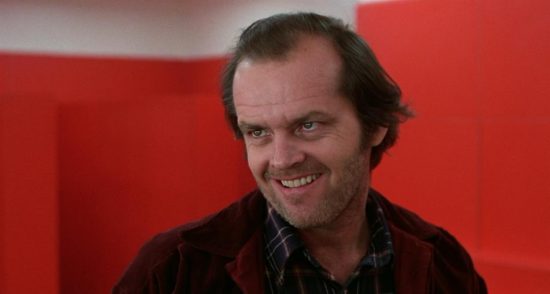Retro Review: The Shining – “The film remains an unsettling and mysterious experience”
Stanley Kubrick’s The Shining (1980) is widely considered a classic of the Horror genre. As with other works from Kubrick’s catalogue such as PATHS OF GLORY (1957), 2001: A SPACE ODYSSEY (1968) and FULL METAL JACKET (1987), THE SHINING transcends its genre origins to become a film that features on many all-time greatest films lists, for both fans and critics alike.
THE SHINING was only the third adaptation of a Stephen King novel to make it to our screens, following in the footsteps of Brian De Palma’s CARRIE (1976) and the TV adaptation of SALEM’S LOT (1979) directed by Tobe Hooper, director of THE TEXAS CHAINSAW MASSACRE (1974). It follows the story of the Torrence family who move to the Overlook Hotel in Colorado for the winter, where father and husband Jack (Jack Nicholson) has taken the job of caretaker at the seasonally deserted hotel with the assistance of his wife Wendy (Shelley Duvall). Their young son, Danny (Danny Lloyd) is warned by his invisible friend called Tommy that they should not go, but refuses to explain why. As time passes in the large hotel miles away from anyone, all is not what it seems as the hotel begins to reveal its dark and mysterious history to the Torrence family.
In a stellar career with iconic highlights such as Roman Polanski’s CHINATOWN (1974), Martin Scorsese’s THE DEPARTED (2006) and Milos Forman’s ONE FLEW OVER THE CUCKOO’S NEST (1975), Jack Nicholson’s manic performance in THE SHINING dominates almost every scene his character inhabits. Kubrick’s unrivalled and obsessive control of the camera, art direction and mise-en-scene contrasts perfectly with the anarchic performance of an actor at his unhinged best. The sense of discomfort, unease and suspense is maximised for an audience who have no idea what his character will do next.
If Nicholson is the unpredictable, anarchic force within the film, then Shelley Duvall’s exhausted and quietly desperate performance provides the fragile humanity that keeps the film from slipping beyond our suspension of disbelief into grotesque pantomime. Even before the family travel to The Overlook, Duvall’s demeanour gives the impression of someone who is already a victim of domestic abuse. Jack is at best, dismissive of his family, whereas Wendy is keeping things together for the sake of them. It is no secret Duvall suffered during the prolonged and infamous shoot, with rumours of strong-arm tactics and even bullying at the hands of Kubrick. In Vivian Kubrick’s MAKING THE SHINING (1980), Stanley Kubrick is seen shouting at Duvall on set, telling members of the crew not to sympathise with her and explaining to Duvall ‘It doesn’t help you’. All while his daughter’s camera is running and we are left to wonder what was not captured on film. Duvall has stated in various interviews over the years although she was glad of the experience and Kubrick was pushing her in order to get the performance right, she would never want to repeat that experience. Whatever the truth, she gives a career-defining performance, moving straight on to make Robert Altman’s misstep, POPEYE (1980) with Robin Williams. She went on to appear in a handful of cinematic releases, but has mainly worked in TV as both actress and producer.
Kubrick presents the world from a unique, single-point perspective. The camera moves deliberately only serving to highlight a sense of unease, create a dreamlike state or focus the eye to experience the moments exactly as the story demands. He uses large, wide-open spaces where characters almost feel lost and insignificant to great effect. The great hall in which Jack Torrence writes is almost too large, even for Nicholson. The keys of his typewriter echo around the vast, empty chamber, like a broken clock. The family’s living quarters, compared to the rest of the building is claustrophobic and oppressive and the labyrinthine hotel corridors are as much a maze as the one outside. His innovative use of Garret Brown’s recently invented Steadicam as we follow Danny on his tricycle is dizzying. Never before were audiences taken on such a ride into the unknown over the shoulder of a young child. We experience the world as Danny sees it, but with an expectation that something wicked this way comes. Yes, Kubrick uses emotion sparingly, which only serves to heighten the engagement and illicit an even greater reaction. The images are as vivid and iconic now as they were shocking and revelatory, 40 years ago.
Editor Ray Lovejoy, who first worked on 2001: A SPACE ODYSSEY uses long and controlled cuts with soft dissolves that draw us into this world and throw us off balance with jump cuts into chapter titles or near-subliminal images of a screaming Danny, blood-stained corpses or tidal waves of blood flooding out of elevators.
Reviews upon its release were mixed with high-profile names such as Roger Ebert and Pauline Kael criticising the film being too cold or failing to deliver on its promises. However, over time the film has come to be widely recognised as one of the great horror films with Ebert himself giving it a 4 star review in 2006 on his website. In terms of box office the film was a reasonable success. Quite the achievement, given it was released at the same time as THE EMPIRE STRIKES BACK (1980), which dominated the domestic market. THE SHINING built steadily throughout the summer and finished with approximately $45million domestically, a profit for the ever-faithful Warner Bros studio.
Stephen King did not take as kindly to it as audiences did. He spent years publicly criticising the film for the many changes made in the film. He would repeatedly state that the film was like a car with no engine. The book makes much more of Jack’s drinking problem, King at the time of writing was struggling with his own alcoholism and there is a deep connection between author and protagonist. King’s Wendy was an ex-cheerleader for whom nothing in life up to that point had been a challenge. The casting of Shelley Duvall in the role rejects this reading of the character and she is much more painted as someone who has lived a life of struggle and adversity. Nicholson’s Jack Torrence is already a far more threatening presence when we first meet him. As John Bleasdale states in his STANLEY KUBLOG, ‘Stephen King’s book is about a good man who goes bad; Kubrick’s film is about a bad man who goes home.’
The film is referenced time and again in popular culture, from John Ritter’s ‘Here’s Daddy!’ impersonation in PROBLEM CHILD (1990) to receiving its own ‘Tree House Of Horror’ episode in THE SIMPSONS (1989 – Present). Rodney Ascher’s documentary ROOM 237 (2012) examines some of the various wild fan theories as to the meaning of the film, from Kubrick’s apology for faking the moon landing footage to an exploration of the holocaust.
THE SHINING has had a huge influence on filmmakers from Robert Egger’s THE WITCH (2015) and more overtly in THE LIGHTHOUSE (2019) to Steven Spielberg’s READY PLAYER ONE (2018) and even John Lasseter’s TOY STORY (1995) where the famous carpet design turns up in the evil Syd’s house.
The film’s ambiguity, refusal to explain or tie up loose ends leave space for us to furnish The Overlook Hotel with our own fears and misgivings. This ensures the film remains an unsettling and mysterious experience, standing up to repeated viewings and the test of time.












